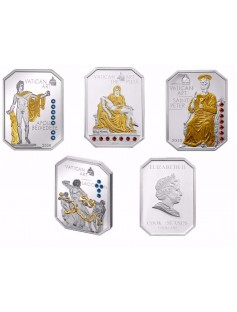Cook Islands 2009-2011 4x5$ Vatican Art 4 Silver Coin Set with Swarovski
- Mintage Limit - 5000
- Each coin in set is struck from 25g. of pure silver
- Gold Gilded with Svarowski Crystal Inserted
- Coin in capsule+with Certificate of Authenticity + Presentation Case
The Pietà (Italian: [pjeˈta*]; 1498–1499) is a work of Renaissance sculpture by Michelangelo Buonarroti, housed in St. Peter's Basilica, Vatican City. It is the first of a number of works of the same theme by the artist. The statue was commissioned for the French Cardinal Jean de Bilhères, who was a representative in Rome. The sculpture, in Carrara marble, was made for the cardinal's funeral monument, but was moved to its current location, the first chapel on the right as one enters the basilica, in the 18th century. It is the only piece Michelangelo ever signed.
This famous work of art depicts the body of Jesus on the lap of his mother Mary after the Crucifixion. The theme is of Northern origin, popular by that time in France but not yet in Italy. Michelangelo's interpretation of the Pietà is unprecedented in Italian sculpture. It is an important work as it balances the Renaissance ideals of classical beauty with naturalism.
Laocoon
This statue group was found in 1506 on the Esquiline Hill in Rome and immediately identified as the Laocoön described by Pliny the Elder as a masterpiece of the sculptors of Rhodes. The story is that during the Trojan War, Laocoön, a priest of Apollo in the city of Troy, warned his fellow Trojans against taking in the wooden horse left by the Greeks outside the city gates. Athena and Poseidon, who were favouring the Greeks, sent two great sea-serpents which have wrapped their coils around Laocoön and his two sons and are killing them. From the Roman point of view, the death of these innocents was crucial to the decision of Aeneas, who heeded Laocoön's warning, to flee Troy, and this led to the eventual founding of Rome. Such an important sculpture could not escape the notice of Pope Julius II (1503-1513) who bought it immediately and had it displayed in the Statues Courtyard (Cortile delle Statue), making it the centrepiece of the collection. There has been much debate over the date of the statue, which would seem to have been made around 40-30 B.C.
The Belvedere Apollo
This statue was part of the collection which Cardinal Giuliano della Rovere held in his palace in Rome. When he was elected Pope as Julius II (1503-1513) the statues was transferred to the Vatican, where it has remained since at least 1508. The god, Apollo, moves forward majestically and seems to have just released an arrow from the bow which he originally carried in his left hand. The work has been dated to mid-way through the 2nd century A.D. and is considered to be a copy of an original bronze statue of 330-320 B.C. by Leochares, one of the artists who worked on the Mausoleum at Halicarnassus.
The statue has always been greatly admired, but owes its fame particularly to Johann Joachim Winckelmann who considered it the sublime expression of Greek art, "of all the works of antiquity that have escaped destruction, the statue of Apollo represents the highest ideal of art".









